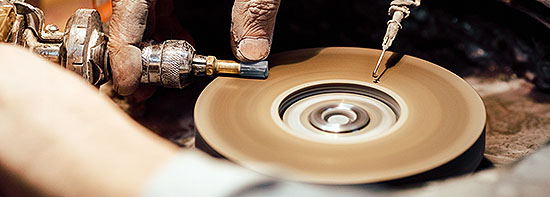How are Diamonds Cut?
- Excellent Cut - light enters with great sparkle facets are like mirrors.
- Very Good Cut - majority of light shines through level is a very high white.
- Good Cut - light enters reflects most light slightly darker lacks contrast.
- Fair – facets are slightly out of alignment light tends to exit through the bottom of the stone.
- D,E,F - Colorless
- G,H,I - Near-Colorless
- J,K,L – Slightly Tinted
- M-R - Colored
- S-Z – Colored
- Blue – caused by boron inclusion
- Yellow – caused by nitrogen inclusion
- Brown – caused by defects
- Green – caused by radiation
- Purple – caused by combination of crystal lattice distortion and high hydrogen content
- Pink - color attributed to enormous amounts of additional pressure during formation, in theory
- Orange – nitrogen like the yellow, however groups in a very hyper-specific way
- Red – gliding atoms in the diamond structure (rarest diamond color known), in theory
- Black – caused by inclusions black gray such as graphite, sulfides and our microscopic fractures
White – caused by opaque or opalescent also caused by microscopic inclusions
Steel Gray - caused by inclusions gray graphite, sulfides and our microscopic fractures

How are Diamonds Cut?
Diamond, Quality of the Cut Scale
What is used to cuts a Natural or Laboratory diamond?
Quick answer: Diamond cutter’s utilize other diamonds and lasers to cut diamonds.
First it is really important to seek the maximum yield from the raw natural or laboratory diamond stone, so planning is where all diamonds begin their journey.
The Diamond Planning Stage
Traditionally after planning, using computers to optimize the amount of quality stones that can be cut from the rough stone are established. This planning process is all about value and carat weight yielding, this is a true high skill art form.
The Diamond Cleavage Stage
The diamond moves to the cleavage stage, diamonds are split and cut using a diamond saw blade
What is Cleavage in diamond cutting?
Cleavage is a mineralogy term used by the diamond cutter’s and the diamond industry, it is described as cleaving or sawing of a rough crystal stone into two or more pieces. Cleaving is the cutter hitting an exact point and direction sharply splitting the stone along a cleaving along a flat plane.
What you are actually doing here is spitting the diamond rough parallel of its triangular, octahedral planes three grains. Example is wood has one grain where a diamond is dealing with four possible directions, this means the starting of the diamond process from that raw stone can be a bit more demanding in the planing of the stone for yeilds.
The Diamond Bruting Stage
This is the rounding of the stones stage using diamond plates spinning in opposite directions grinding one stone against another creates this rounded stone as well as lasers are able also help and assist in producing expertly cut stones.
What is Bruting in diamond cutting?
This part of the process is also referred to as girdling, this is the art of making a stone round, it can be, as mentioned above that there are two diamonds grinding against one another, or it can involve a diamond impregnated disk rubbing against a solo diamond to gain its finish as an ideal cut. Industrial diamonds are also used to cut, through grinding on these stones as well.
The Diamond Polishing Stage
This is where a stone is cut shaped into its final form as it facets are cut and polished as they are moved through the polishing stage, this is a very important stage.
Making the diamond appear much heavier
Besides the cut and grade there is the spread for the diamond, this is the ability of the diamond cutter’s to make a diamond appear to be a heavier carat weight then it it actually weighs in at.
The Diamond Inspection Stage
This final stage is where the industries top experts assure the stones have been finished to the top of the quality scale as each diamonds goal is to seek the status of Brilliant. Brilliant diamonds are the highest level any diamond can be graded to. A diamond is graded on its facets, angles and cuts.
What most mined diamonds look like
Diamond colors explained from the mining operations point of view. Most diamonds mined range in colors from pale yellow to brown and this is considered the normal color range. Diamonds that are intense yellow or brown or any other color are called fancy colored diamonds and are processes and graded accordingly.
Diamonds colorless are of the highest grade qualities and can look white, they are actually bright white and appear to be white to the eye. Diamond Colorless Chart NON-Fancy. The goal here is to have the most transparent diamond one can acquire.
Diamond Fancy Colors and how they are formed in nature
Natures Colored Diamonds. It is near impossible and thus very rare to be able to, during the diamond atom structure as it a very rigid formulation of the structure during the growing processes to deviate, not impossible just really rare.
This is because when a diamond crystalline structure is forming the process does not easily allow for impurities to contaminate a carbon diamonds growth, these contaminates in the natural development process are what often allow a diamond to establish a color.
There are only clear diamonds and 12 natural colors including the clear:
